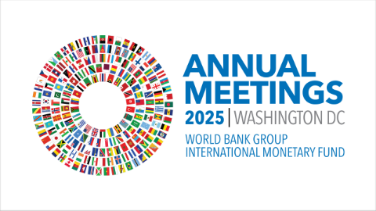WASHINGTON DC, October 15 (IPS) – Countries across the Global South face an accelerating climate crisis, tepid growth, and unsustainable levels of debt. Yet hopes of finding support at the International Monetary Fund’s (IMF) Annual Meetings in Washington are dim. The IMF is tightening its purse strings — even as it leaves untouched a vast treasure of more than 3,000 tons of gold that offers a prime opportunity to stabilize the global economy.
Meanwhile, with prices at record highs, the IMF should use its gold reserves to fund much-needed support for developing countries.
While IMF lending yielded record income in FY2024, fears that Trump will cut off funding — combined with the organization’s exposure on an ill-advised, US-directed mega-loan to Argentina — have prompted the Fund to reassess its assistance to those most in need.
At last year’s meetings, the IMF implemented a system of tiered interest rates on loans made through the Poverty Reduction and Growth Trust (PRGT) — a formerly interest-free lending facility for low-income countries.
The Fund also elected to maintain (if slightly modify) its controversial “surcharge” policy, which generates revenue for the IMF by charging onerous fees to highly indebted middle-income countries. Income from surcharges is now effectively being used to fund the PRGT, forcing these distressed countries to subsidize the Fund’s concessional lending.
Yet while the IMF squeezes financing from the very countries it is meant to support, it is, in fact, sitting on hundreds of billions of dollars worth of idle firepower.
When the Fund was founded in 1944, members were required to pay at least a quarter of their initial contribution in gold, which at the time was the foundation of the global monetary order. The gold standard is long gone, but the IMF still holds 90.5 million ounces — or over 3,000 tons — of the precious metal, historically held at the central banks of major shareholders.
Critically, this gold is still on the IMF’s books at a price determined in 1944: roughly $48 per ounce. This year, amid geopolitical uncertainty and increased demand from central banks, prices soared to all-time highs; for the first time ever, gold prices now exceed $4,000 per ounce.
In other words, the IMF’s gold reserves are worth over 85 times more than its accounting would suggest.
Selling just 1.5 percent of these holdings would cover the income generated from all surcharge payments through 2030. Selling 10 percent would cover the PRGT’s entire current lending envelope for a decade.
There’s precedent for such a move. In 1999, when gold was $282 per ounce, the IMF sold about 444 tons of gold directly to IMF members, who immediately returned it at the same price in fulfillment of outstanding debts.
The IMF was thus left with the same quantity of gold holdings, but with about $3 billion in profit to provide debt relief for low-income countries as a part of the celebrated Heavily Indebted Poor Countries Initiative.
In 2009, with gold prices still less than a third of today’s, the IMF board agreed to sell an eighth of its holdings outright, generating $15 billion in proceeds, a portion of which was transferred to the PRGT.
So, what’s stopping the IMF from doing the same today?
An agreement to sell gold reserves requires an 85 percent vote of the IMF board. As the proceeds from gold sales are, by default, distributed to IMF members in proportion to their quotas, a sale to bolster IMF lending power would require prior commitment from members to return their share of the windfall. But these political hurdles have been cleared before, in both 1999 and 2009.
While the US, which alone holds an effective veto over major IMF decisions, would have to agree to any arrangement, it’s difficult to see a cause for objection. Strengthening global economic stability — and therefore demand for US exports — at no new cost to the United States should hardly run afoul of an “America First” agenda.
Moreover, common concerns about the impacts of a sale on the gold market mean little in today’s context. With prices at record highs, the market can easily weather any price drops from an IMF sell-off, which can in any case be mitigated through the use of phased sales and off-market transactions.
And while some have historically fretted over the prudence of selling off a portion of the institution’s “rainy day” fund, selling while prices are sky-high makes good financial sense, and would easily leave plenty for future need.
Even if the political challenges to a gold sale prove insurmountable, there may still be a way to unlock its benefits; the IMF can simply revalue its gold holdings to match the market price, thus increasing the assets on its books without conducting even a single transaction.
Germany, Italy, and South Africa have all recently taken similar actions with their national gold holdings, and there is some speculation that the United States might follow suit. In fact, the IMF’s own accounting guidelines recommend countries value gold holdings at the market rate.
Awareness of the need to tap the IMF’s undervalued gold reserves is growing. In the past year, leading experts, top officials from Brazil and South Africa, and the G-24, which represents developing country interests at the Fund, all called on the organization to consider a gold sale.
Seeing that call through would take additional political will. But if the alternative is letting developing countries founder in the current crisis — or worse, bleeding them dry in order to protect the IMF’s balance sheets — then the choice couldn’t be clearer.
Michael Galant is a Senior Research and Outreach Associate, and Ivana Vasic-Lalovic is a Senior Research Associate, at the Center for Economic and Policy Research (cepr.net) in Washington, DC
IPS UN Bureau
© Inter Press Service (20251015062550) — All Rights Reserved. Original source: Inter Press Service


